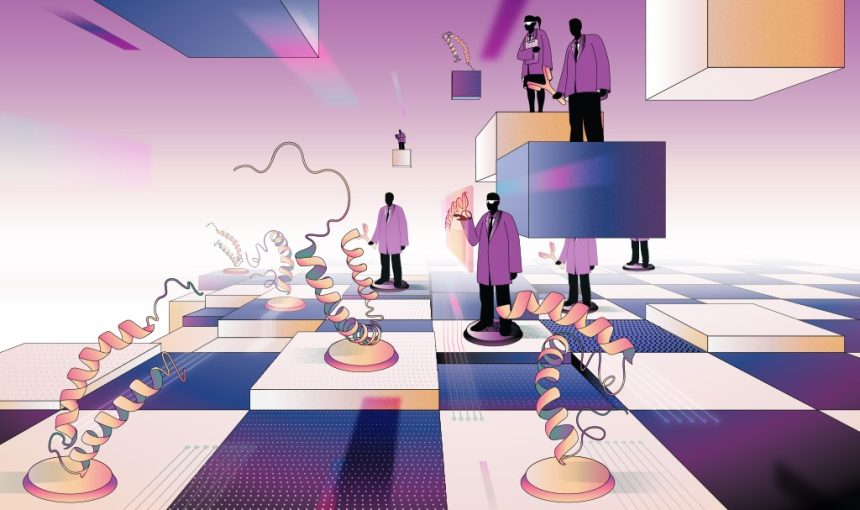In the search for new drugs for critical diseases, generative AI might be the helping hand researchers need to speed up a years-long process.
Asian Scientist Magazine (Oct. 12, 2023) — Saurabh Singal is a chess enthusiast. His friends include grandmasters at the game. They’re also part of an eclectic team he leads in a different kind of game: one which could impact millions of lives worldwide.
On one side of the board: alphasynuclein, a key protein responsible for Parkinson’s disease. On the other: a crew of computer scientists like Singal, biochemists, biophysicists, mathematicians and artificial intelligence (AI) engineers.
Gathered in a collaboration between the Indian Institute of Technology (IIT) Delhi and Singal’s own data science company KnowDis, Singal’s crew aims to tap into generative AI to discover new treatments — specifically, antibodies — that might counteract alphasynuclein’s effects on the brain, helping slow or stop the debilitating effects of Parkinson’s and other similar neurodegenerative diseases.
“You might wonder what a chess grandmaster could do in this case,” Singal chuckled during an interview with Asian Scientist Magazine. “Well, when it comes to trying to understand how a protein might avoid getting ‘captured’, they can offer exceptional insights.”
Drug discovery typically starts with two key steps: finding a target and finding a drug that can hit that target. These targets are often sites on protein molecules that, once bound to, stop or alter their activity, thus reducing the effects of diseases they’re linked to. Like a key slotting in a lock, drugs often need to have very specific shapes and chemical compositions to effectively fit in and bind to those sites.
But alpha-synuclein is a particularly slippery opponent. It’s what scientists call an intrinsically disordered protein (IDP): a molecule with a constantly changing three-dimensional structure. This adds an extra layer of difficulty both in trying to find a target and figuring out what drug might hit the mark.
So how do you find the key to a shapeshifting key hole? First, you need to work out the rules it plays by; then you teach a computer to help you outplay it.
AI isn’t a new tool in medical research. “There’s been years of work in this area with supervised learning algorithms, which essentially learn by example,” Sayan Ranu, a computer scientist and associate professor at IIT Delhi’s Yardi School of AI, told Asian Scientist Magazine.
An expert in machine learning and a member of the KnowDis-IIT team, Ranu gives a simple illustration of how these algorithms work.
“Suppose we wanted to teach an AI how to solve a problem: ‘where is the elephant in this photo?’ We would train it with a dataset of thousands of photos with and without elephants, each one labeled accordingly.”
With enough training, the algorithm would learn to associate certain common image features, like an elephant’s tusks and trunk, with the ‘elephant’ label. After that, if the AI was shown an unlabeled image, it could assess which part contained an elephant based on those common features.
Swap elephant photos for tumor scans, said Ranu, and you have a potentially powerful tool to speed up medical research. Such neural networks have already been helping researchers in tasks ranging from uncovering new treatments for malaria to identifying cancer-causing proteins. Given the right references and enough processing power, computers can sift through millions of chemical compounds known to science and highlight the ones that might closely match a molecular target, shortening years-long research timelines to months.
But what if you don’t have enough elephant photos for an AI to refer to? Or what if you don’t actually know what an elephant looks like, but only have a list of features that define one? What if the problem posed isn’t “where is the elephant” but “what could an elephant look like”? That’s where generative AI comes in.
“[It] takes a different approach,” said Ranu. “Rather than aiming to identify patterns from a large dataset, generative AI can create new, potentially useful data based on the rules it’s given about how to solve a problem.”
In the search for new drugs, generative AI offers an alternate solution to challenges encountered using previous AI methods. There aren’t always large enough databases of potentially medically helpful molecules to teach an AI with. On the other hand, a database might be so extensive that even the most powerful computers would struggle to sift through it for a match to a molecular target.
On top of these hurdles, it’s entirely possible that no molecule currently known to science might work on a particular disease target. But generative AI, Ranu added, could potentially be used to design a new molecule just for that purpose.
While alpha-synuclein normally helps out a healthy brain in key functions like nerve signaling and intracellular traffic control, trouble brews when an errant alphasynuclein molecule happens to shapeshift — thanks to either its own intrinsically disordered behavior, or a genetic mutation — in a way that causes it to latch onto another.
“Two alpha-synuclein monomers can form a dimer, which can then combine with more to form oligomers; eventually, they start aggregating into these insoluble masses that impair the nerve signaling process,” said Singal.
It’s a common thread across many diseases like Parkinson’s: the abnormal buildup of proteins like alphasynuclein either within brain cells (seen in Parkinson’s) or between them (seen in Alzheimer’s), causing nerve damage linked to increasingly severe symptoms like dementia and impaired muscle control. Once these masses form, it’s hard to get rid of them.
Antibodies offer one solution, said Singal: being proteins themselves, they’re naturally produced by our own immune systems to fight diseases by binding to unique disease-related molecules (antigens). If they could bind to alpha-synuclein in a way that stops them from agglomerating, they could prevent any further nerve damage.
However, finding the correct antibody is the challenge. The secret of antibody specificity lies in complementarity determining regions (CDRs): looped sections of amino acids on the prongs of an antibody’s Y-shaped molecular structure. Like the ridges on a key, small variations in CDRs can make the difference between an antibody that hits a particular viral protein versus otherwise.
It can be a mathematically daunting prospect: a single human antibody carries 12 CDRs, with each CDR a chained sequence of amino acids typically between 7 to 13 units long, and each amino acid unit one of 20 possible types.
“There’s a huge possibility space to explore,” Gaurav Goel, associate professor of chemical engineering at IIT Delhi, told Asian Scientist Magazine. “There’s a well known public database of antibody sequences known to science, called the Observed Antibody Space (OAS), with over a billion molecules registered. But even those don’t represent the full sum of unique human antibodies that could feasibly exist.”
Adding to this, the OAS still lacks enough detailed structural data on antibody-antigen complexes that occur in real life, partly because analyzing them requires expensive and laborious lab procedures, said Goel.
“That’s the crux of why we’re looking into generative AI,” said Goel. “We wouldn’t be limited to selecting from recorded sequences, or testing every antibody from a billion-sequence database against each new antigen.
If you could teach an AI the language of proteins, the molecular dynamics involved, you could theoretically design an antibody for any antigen.”
To support their AI models, Goel is assisting the KnowDis-IIT team in developing computer simulations that could precisely replicate the molecular dynamics of proteins for training purposes. Their aim is to eventually develop a generative AI platform that could create antibodies not only for alpha-synuclein, but a wider range of disease-related molecules.
“Rather than trying to find the right needle — or key, in this case — in a haystack, we could forge one instead,” said Singal.
Artificially-produced antibodies are already being used to treat diseases ranging from cancer to COVID-19, but their development is often a costly process spanning years.
Many candidate treatments fail before they reach clinical trials; those that succeed are often priced high to cover the costs of those that did not.
To Goel, generative AI offers the possibility not only to reduce their costs, but to speed up timelines and open doors to more personalized medicine. Imagine, he said, if you could create an antibody for a specific patient’s form of disease in a matter of weeks after their diagnosis, rather than years too late.
The KnowDis-IIT team is far from the only researchers in Asia eyeing this prospect. Biotech startups to pharmaceutical giants are taking a similar interest, working hand in hand with big tech corporations and governments to develop generative AI’s potential in drug discovery on a larger scale.
In March 2023, Japanese pharmaceutical giant Mitsui & Co. and US tech giant Nvidia announced a collaboration to develop the Tokyo-1 DGX, declared as “Japan’s first generative AI supercomputer.” This open access system will be available to researchers across the country once it goes online. “Tokyo-1 is designed to address some of the barriers to implementing data driven, AI-accelerated drug discovery in Japan,” said Hiroki Makiguchi, product engineering manager at Xeureka, a Mitsui subsidiary and operators of Tokyo-1.
Back in Delhi, Singal’s team works with smaller-scale machines onsite and cloud computing resources similar to Tokyo-1. While they may not have the finances to pull in heavier and costlier hardware, they’re developing new computer science techniques to drastically speed up their simulations; some entirely new to the field, said Singal.
“Our team has brilliant people across the board,” Singal said with a smile. “We’re pretty confident we’re among the key contenders in this game.”
—
This article was first published in the print version of Asian Scientist Magazine, July 2023.
Click here to subscribe to Asian Scientist Magazine in print.
—
Copyright: Asian Scientist Magazine. Illustration: Lieu Yi Pei



